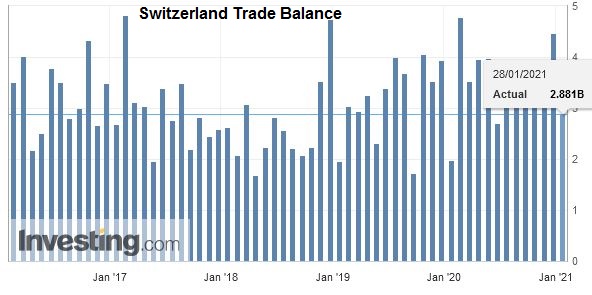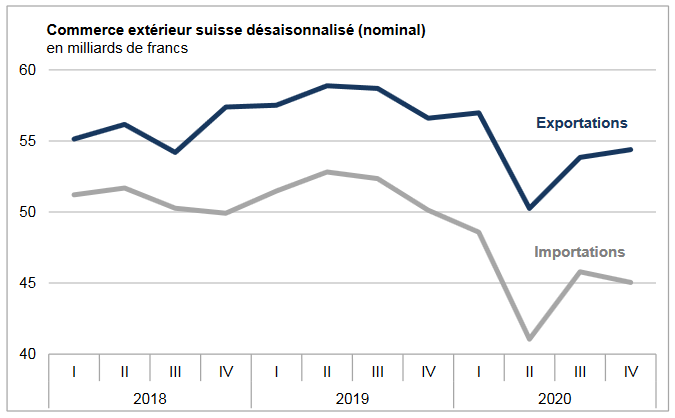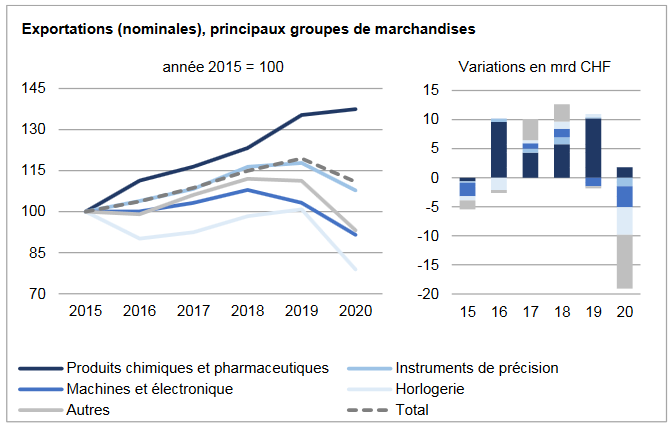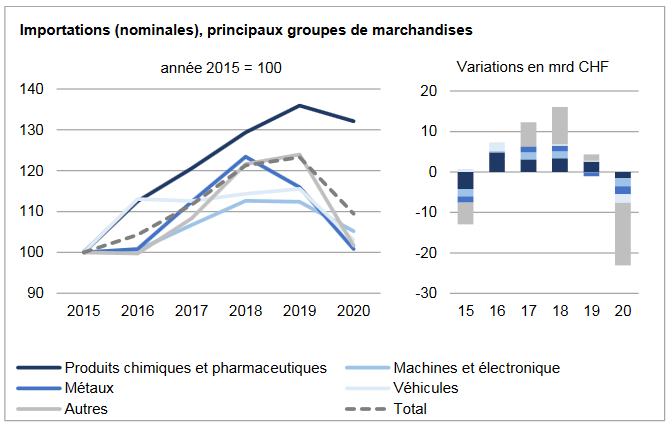We do not like Purchasing Power or Real Effective Exchange Rate (REER) as measurement for currencies. For us, the trade balance decides if a currency is overvalued. Only the trade balance can express productivity gains, while the REER assumes constant productivity in comparison to trade partners.
Who has read Michael Pettis, knows that a rising trade surplus may also be caused by a higher savings rate while the trade partners decided to spend more. This is partially true. Recently Europeans started to increase their savings rate, while Americans reduced it. This has led to a rising trade and current surplus for the Europeans. But also to a massive Swiss trade surplus with the United States, that lifted Switzerland on the U.S. currency manipulation watch list.
To control the trade balance against this “savings effect”, economists may look at imports. When imports are rising at the same pace as GDP or consumption, then there is no such “savings effect”.
After the record trade surpluses, the Swiss economy may have turned around: consumption and imports are finally rising more than in 2015 and early 2016. In March the trade surplus got bigger again, still shy of the records in 2016.
Swiss National Bank wants to keep non-profitable sectors alive
Swiss exports are moving more and more toward higher value sectors: away from watches, jewelry and manufacturing towards chemicals and pharmaceuticals. With currency interventions, the SNB is trying to keep sectors alive, that would not survive without interventions.
At the same time, importers keep the currency gains of imported goods and return little to the consumer. This tendency is accentuated by the SNB, that makes the franc weaker.
Texts and Charts from the Swiss customs data release (translated from French).
Exports and Imports YoY DevelopmentSwitzerland’s 2020 foreign trade will bear the brunt of the consequences of the COVID-19 pandemic: exports (-7.1% to 225.1 billion francs) and imports (-11.2% to 182.1 billion) posted a historic decline. Never before have they suffered such a significant quarterly decline as in the second quarter of 2020. Foreign trade has fallen back to its level recorded three years earlier. The trade balance closed the year with a record surplus of CHF 43.0 billion. In brief ▼ Foreign trade plunged by 40 billion francs in 2020 ▼ Jewelery and watches account for 50% of the drop in exports ▼ Imports of jewelery and jewelry: -9.0 billion francs ▲ Exports: the chemistry-pharma against the tide of the negative trend ▲ Trade with China reaches a record level in both traffic directions |
Swiss exports and imports, seasonally adjusted (in bn CHF), Q4 2020(see more posts on Switzerland Exports, Switzerland Imports, ) |
| Global evolution
After four years of growth, Swiss foreign trade suffered greatly in 2020. Exports fell 7.1% year on year (-17.3 billion francs; real: -11.0%), while imports contracted by 11.2 % (- 23.1 billion; real: -13.6%). For the two traffic directions, this is the second most important annual setback after that of 2009. Foreign trade has thus practically fallen back to its 2017 level. resume some colors in the 3rd and 4th trimesters. Due to a larger decline at entry than at exit, the trade balance ended the year with a record surplus of 43.0 billion francs. |
Switzerland Trade Balance, December 2020(see more posts on Switzerland Trade Balance, ) Source: investing.com - Click to enlarge |
| Exports to Franceau lower since 2000
In 2020, all sectors posted red figures at the exit, with the exception of chemical and pharmaceutical products (+ 1.6% or +1.8 billion francs). Jewelery and watchmaking were the hardest hit, with sales falling by a third (-4.0 billion) and a fifth (-4.7 billion) respectively. Next are the machinery and electronics sectors as well as metals, down 11%; this duo had already suffered a contraction in 2019. In chemistry-pharma, immunological products (+2.8 billion francs) as well as active ingredients (+1.1 billion) played the role of locomotive. In the three main markets, the Swiss export industry has seen its sales deteriorate. Down 8.8% (-4.6 billion francs), Asia was the most affected. While the cumulative decline of Hong Kong and Japan reached 3.0 billion francs, China advanced 1.3 billion francs (primarily chemicals, pharma and watches) to set a new high at 14.7 billion francs. Exports to Europe fell by 6.2% (-8.1 billion francs), where Germany, France, the United Kingdom and Italy weighed on the result. The French partner suffered a historic contraction (-2.5 billion francs) to fall to its lowest level since 2000. Turnover with North America fell by 6.1%; with the USA, it fell from 2.5 billion to 39.5 billion francs. |
Swiss Exports per Sector December 2020 vs. 2019(see more posts on Switzerland Exports, Switzerland Exports by Sector, ) |
| Imports: with a share of 4%, jewelry induces 40% of the overall decrease
At the outset, the decline affected the entire range of products, with the exception of textiles (especially clothing and protective masks) as well as food, beverages and tobacco (group of other goods). The general decrease can be explained in large part by the plunge in jewelry and jewelry (notably pourre-cast gold jewelry), whose arrivals have halved over one year (-9.0 billion francs). Imports of energy products have also been crushed by the black (-3.8 billion). The vehicles, machinery and electronics sectors as well as metals saw their imports fall by around 2 billion francs each. Those of chemical and pharmaceutical products lost 1.5 billion francs, weighed down by the fall in active ingredients and raw and basic materials. Conversely, drugs increased by 3.4 billion francs Imports from the three main economic regions lost ground. The biggest drop was in North America (-16.0%; USA: -2.4 billion francs). A double-digit decline also characterized Europe (-11.2%), where Germany, the United Kingdom, Ireland, France and Italy in particular suffered a heavy setback. Asiese deliveries were down 9.9%, mainly due to the drop with the United Arab Emirates (-5.9 billion; gold jewelry for overhaul). Conversely, China (textiles and clothing), Singapore (+ 60%; chemicals-pharma) and Japan posted cumulative growth of 2.8 billion francs; the first two have also achieved a record level. |
Swiss Imports per Sector December 2020 vs. 2019(see more posts on Switzerland Imports, Switzerland Imports by Sector, ) |
Tags: Featured,newsletter,Switzerland Exports,Switzerland Exports by Sector,Switzerland Imports,Switzerland Imports by Sector,Switzerland Trade Balance





























